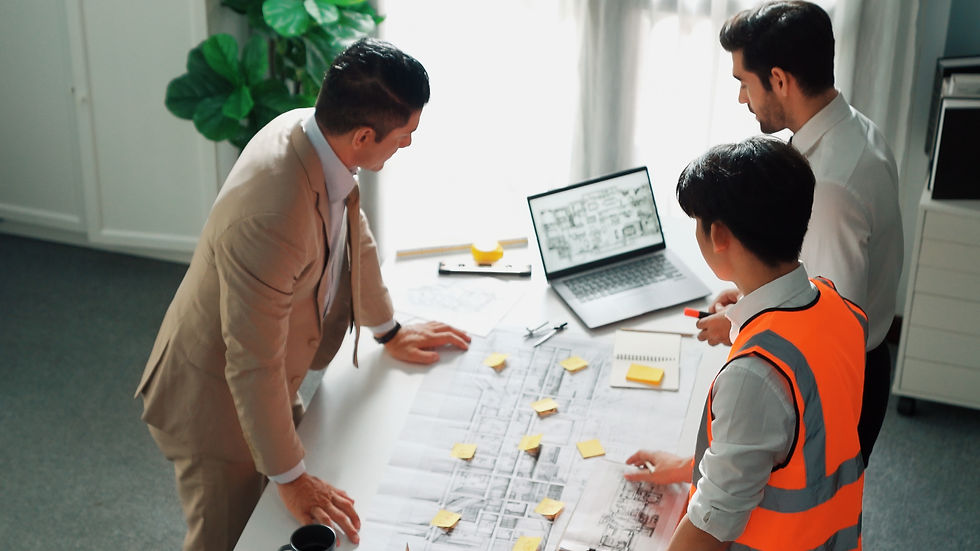Optimizing Building Efficiency with HVAC Design
- PV Digital

- Aug 18
- 4 min read
Efficient building operation depends heavily on the design of its heating, ventilation, and air conditioning (HVAC) system. A well-designed HVAC system not only ensures occupant comfort but also significantly reduces energy consumption and operational costs. This article explores how optimizing HVAC design can enhance building efficiency, providing practical insights and actionable recommendations.
The Importance of HVAC Design in Building Efficiency
HVAC design plays a crucial role in determining a building's energy performance. Poorly designed systems can lead to uneven temperature distribution, excessive energy use, and increased maintenance costs. Conversely, an optimized HVAC design ensures:
Consistent indoor comfort by maintaining ideal temperature and humidity levels.
Energy savings through efficient equipment selection and system layout.
Improved air quality by incorporating proper ventilation and filtration.
Reduced environmental impact by minimizing carbon footprint.
For example, integrating variable air volume (VAV) systems allows for precise control of airflow based on occupancy, reducing unnecessary energy use. Additionally, zoning strategies can tailor heating and cooling to specific areas, avoiding waste in unoccupied spaces.

Efficient ductwork layout improves airflow and reduces energy loss.
Key Principles of Effective HVAC Design
To optimize building efficiency, HVAC design must consider several fundamental principles:
1. Load Calculation and Analysis
Accurate load calculation is the foundation of HVAC design. It involves assessing the heating and cooling demands of the building based on factors such as:
Building orientation and envelope insulation
Occupancy patterns and internal heat gains
Local climate conditions
Using software tools or manual calculations, designers can determine the precise capacity needed for HVAC equipment, avoiding oversizing or undersizing.
2. Equipment Selection
Choosing the right HVAC equipment is essential for efficiency. High-efficiency boilers, chillers, and air handlers reduce energy consumption. Additionally, incorporating energy recovery ventilators (ERVs) can reclaim heat from exhaust air, further lowering energy use.
3. System Layout and Zoning
Designing an effective system layout minimizes pressure drops and energy losses. Proper zoning allows different areas to be conditioned independently, matching comfort needs and occupancy schedules.
4. Controls and Automation
Advanced control systems enable real-time monitoring and adjustment of HVAC operations. Programmable thermostats, occupancy sensors, and building management systems optimize performance and reduce waste.
5. Maintenance Accessibility
Designing for easy maintenance ensures that HVAC systems operate at peak efficiency over their lifespan. Accessible components and clear documentation facilitate timely repairs and inspections.

Smart controls enhance HVAC system responsiveness and efficiency.
What is HVAC System Design?
HVAC system design is the process of planning and specifying the components and layout of heating, ventilation, and air conditioning systems within a building. It involves:
Assessing building requirements to determine heating and cooling loads.
Selecting appropriate equipment based on capacity, efficiency, and compatibility.
Designing ductwork, piping, and ventilation to distribute conditioned air effectively.
Integrating control systems for optimal operation and energy management.
This design process requires collaboration between architects, engineers, and contractors to ensure the HVAC system complements the building’s structure and usage.
For instance, in a multi-story office building, HVAC design must account for varying heat loads on different floors, ensuring that each zone receives adequate conditioning without excessive energy use.

Proper duct installation is critical for efficient air distribution.
Practical Strategies to Optimize HVAC Design for Efficiency
Implementing the following strategies can significantly improve HVAC system performance and building efficiency:
Use Energy Modeling Software
Energy modeling tools simulate building performance under various HVAC configurations. This allows designers to compare options and select the most efficient system before construction begins.
Incorporate Renewable Energy Sources
Integrating solar thermal systems or geothermal heat pumps can reduce reliance on fossil fuels and lower operating costs.
Prioritize Building Envelope Improvements
Enhancing insulation, sealing leaks, and installing energy-efficient windows reduce heating and cooling loads, allowing smaller HVAC systems to be used.
Implement Demand-Controlled Ventilation
Adjusting ventilation rates based on occupancy and indoor air quality reduces unnecessary conditioning of outside air.
Schedule Regular Maintenance
Routine inspections and cleaning of HVAC components maintain system efficiency and extend equipment life.
Collaborate with HVAC System Design Experts
Engaging professionals who specialize in hvac system design services ensures that the latest technologies and best practices are applied to your project.
Future Trends in HVAC Design for Building Efficiency
The HVAC industry is evolving rapidly with innovations that promise even greater efficiency gains:
Smart HVAC Systems: Integration with IoT devices enables predictive maintenance and adaptive control based on real-time data.
Advanced Materials: Use of phase-change materials and improved insulation enhances thermal regulation.
Decentralized Systems: Smaller, localized HVAC units reduce energy losses associated with large central systems.
Sustainable Refrigerants: Adoption of low-global warming potential refrigerants minimizes environmental impact.
Staying informed about these trends allows building owners and designers to future-proof their HVAC systems.
Enhancing Building Performance Through HVAC Design
Optimizing HVAC design is a critical step toward achieving energy-efficient, comfortable, and sustainable buildings. By focusing on accurate load calculations, smart equipment choices, effective zoning, and advanced controls, buildings can reduce energy consumption and operational costs significantly.
Whether designing new construction or retrofitting existing buildings, leveraging expert hvac system design services can provide tailored solutions that meet specific needs and regulatory requirements.
Investing in thoughtful HVAC design not only improves occupant comfort but also contributes to environmental stewardship and long-term financial savings.





Comments